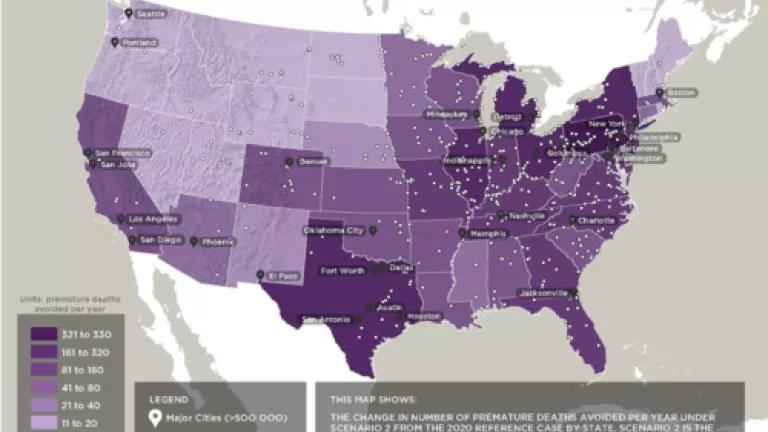
Researchers from Harvard, Boston and Syracuse universities have published new estimates of how many lives can be saved each year by EPA’s proposed carbon pollution standards for the nation’s 1500 fossil-fueled electric power plants. They’ve concluded these first-time carbon limits can save the lives of 3,500 Americans each year in 2020 and thereafter. That’s a pretty significant number.
How does this happen? Turns out, the lowest-cost ways to cut power-plant carbon pollution—including generating electricity from cleaner power plants and reducing the amount of electricity we need by using it more efficiently—also make big reductions in so-called “co-pollutants” that spew out of power-plant smokestacks along with the CO2. We’re talking here about dangerous sulfur dioxide, nitrogen oxides, and particulate matter. These pollutants increase lung-cancer risk, along with the risk of heart attack, asthma attacks, and life-threatening respiratory diseases like emphysema. When you make cleaner electricity and use it more efficiently, you burn less coal. You get a lot less carbon pollution, and a lot less of the pollution that produces dangerous soot and smog. And that saves lives. Such are the “co-benefits” of cutting carbon pollution.
This map from a Harvard/BU/Syracuse study shows the states with the most lives to save under the Clean Power Plan. In descending order, they are: Pennsylvania; Ohio; Texas; Illinois; Michigan; New York; North Carolina: Georgia; Missouri; Virginia; Tennessee; and, Indiana.
Just to give you a sense of how big that 3,500-lives number is, it’s seven times more people than die each year in the U.S. from the flu and about the same number of Americans who drown. It’s more than 20 percent of those murdered in this country. In other words, it’s a lot of people. And it’s not an abstraction: These are people we hold dear—our parents, our friends, and (for those of us getting on in years) our grown-up children. (This particular study didn’t look at health risks to kids.) All of us are threatened by power-plant emissions.
Carbon-cutting plans like the EPA’s can prevent other serious illnesses, too—more than 200 heart attacks a year and a thousand hospitalizations from heart disease and respiratory ailments.
These “co-benefits” have a human face. The Harvard, BU and Syracuse study tells us that the EPA’s Clean Power Plan can protect the people we love. And, as a co-benefit of these co-benefits, it’ll cut the huge amount of money we spend on healthcare for diseases and deaths that we can prevent.
Not surprisingly, the study shows that many states with the most coal-plant pollution have the most lives to save–or to keep losing. This is beautifully illustrated in the Harvard/BU/Syracuse study’s maps. They lay out the benefits state by state, and show which areas have the most to gain. Using scenarios similar to EPA’s initial proposal the researchers found residents of states like Michigan would hit the decreased-mortality jackpot, lowering their cumulative adult deaths by well over 300 a year. Things can look up, too, for residents of western Pennsylvania, eastern Ohio, Utah, New Mexico, and the Ohio River Valley.
So next time you hear a fossil-fuel-funded pol spout off about the dangers of the Clean Power Plan, ask what he is doing to protect the lives and health of his constituents from the dangers of power-plant pollutants.
Bottom line: The Clean Power Plan isn’t just a program to help stabilize the climate. It is also a valuable investment in Americans’ health and well-being.

